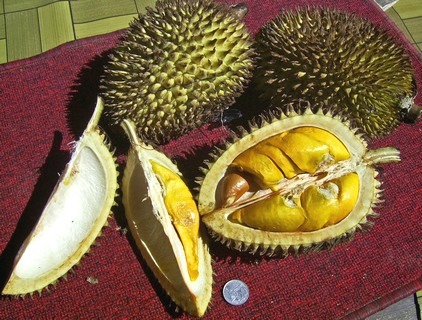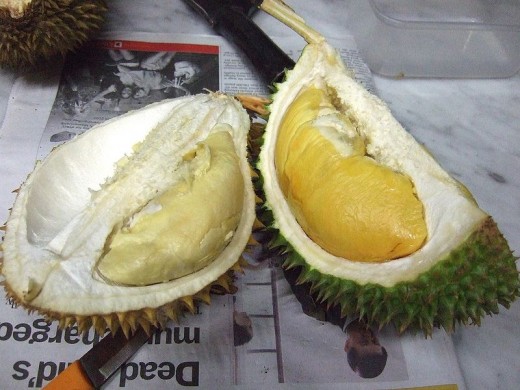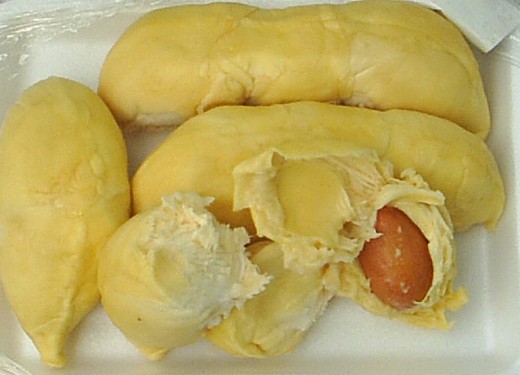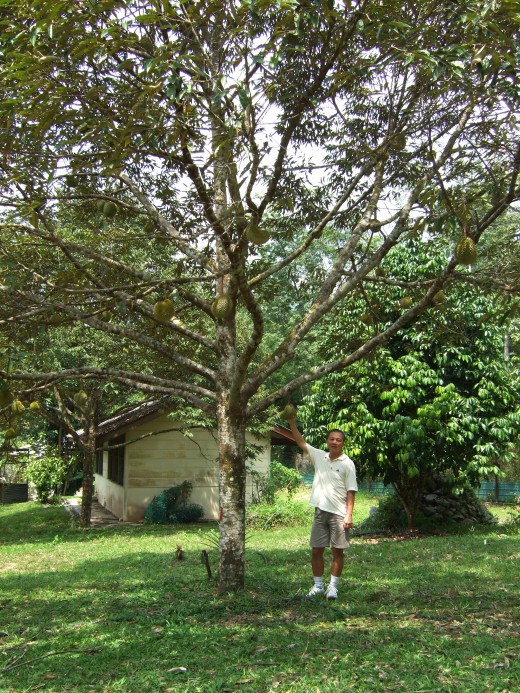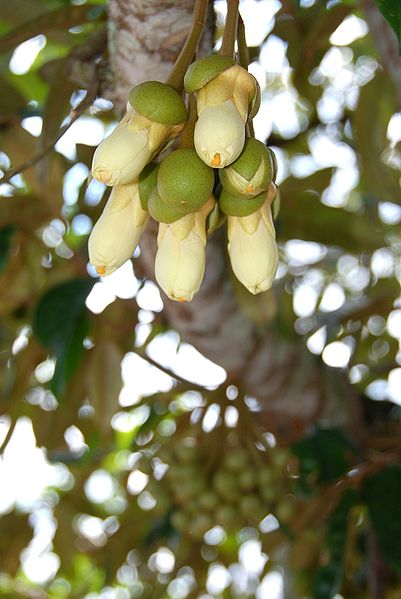What are the Benefits of Durian
Where did Durian Originate
This plant has a very long history in southeast Asia stretching back to prehistoric times. Like so many other plants with a long indeterminate history, durian's origins can be hard to trace, but at this point in time it is thought the plant originated in Sumatra and Borneo.
The word "Durian" itself is Malaysian where "duri" means thorn and the "n" on the end makes the word a noun.
What confuses it's origins is the durian has been consumed for thousands of years and been transported, planted, and cultivated in various regions of southeast Asia for at least this long. Because the species has been grown, died off, and regrown in various parts of the eastern world, tracing it's origins has been difficult at best.
Tracing it to Borneo and Sumatra is based solely on the fact that there appear to be wild varieties of this plant growing in these regions, where almost everywhere else the plant is found it has been cultivated.
Because of the size of the both the fruit and the seed there is little doubt that the primary means of natural distribution occurs when animals eat the pulp (and seed), move to a new area, and expel the digested durian elsewhere. Clearly, humans were part of that process too.
Finally, since durian does not do well in temperate climates it is a tropics only plant. It will not grow above two thousand feet of elevation and must have abundant rainfall to thrive. Areas that are close to sea-level and experience seasonal monsoons are the best locations for these plants to thrive.
Saving Durian Seeds for Planting
Exposed seeds will lose viability quickly and any exposure to sunlight destroys their ability to germinate. Only with special handling, including sterilizing the surface of the seed and keeping them in dark cool containers (68° F) will allow a grower to keep them viable beyond thirty days.



Harvesting Durian
A durian fruit has reached ripeness when it falls from the tree.
This is a dangerous proposition since the trees can grow to anywhere from ninety to one hundred twenty feet tall. From that height a spiky surfaced five to eighteen pound fruit can cause considerable damage or even death.
Villages where an annual harvest takes place, often build temporary shelters near the orchards where the farmer can wait for the fruit to fall and then gather them up. Harvest usually takes six to eight weeks.
The time between flowering, which takes place in March and April, and fully formed fruit takes about four and a half months making the ideal harvesting season sometime in July and August. Once the fruit has fallen it is ripe within two to four days. The fruit should then be eaten within five or six days before they go bad.
Because the smell of durian can be detected up to half a mile away it is attractive to a huge variety of animals including, but not limited to, humans, squirrels, mouse deer, pigs, orangutan, elephants, and even tigers.
Harvesters often take advantage of this fact by setting traps for these animals around the orchard thereby supplementing their diet when the aforementioned animals come to investigate the smell.


Nutritional Value of Durian
Durian is high in a wide range or minerals and vitamins. A three and a half ounce serving contains 144 calories, 3 grams of protein, 4 grams of fat, 12 grams of simple sugars and 12 grams of starch (for a total of 34 grams of carbohydrates) and 2 grams of fiber.
The mineral content is 9 milligrams of calcium, 44 milligrams of phosphorus, 1 milligram of iron and trace amounts of carotene. They also contain vitamin C and a complement of "B" vitamins.
On The Smell of Durian
Ripe durian has a pungent unmistakable smell. Some find it agreeable while others find it repulsive. For this reason southeast Asian airlines have long banned it's transport on commercial flights.
On the negative side of the smell the following;
"...its odor is best described as pig-[feces], turpentine and onions, garnished with a gym sock. It can be smelled from yards away. Despite its great local popularity, the raw fruit is forbidden from some establishments such as hotels, subways and airports, including public transportation in Southeast Asia" - Richard Sterling
On the positive attributes the following;
"The five cells are silky-white within, and are filled with a mass of firm, cream-coloured pulp, containing about three seeds each. This pulp is the edible part, and its consistence and flavour are indescribable. A rich custard highly flavoured with almonds gives the best general idea of it, but there are occasional wafts of flavour that call to mind cream-cheese, onion-sauce, sherry-wine, and other incongruous dishes. Then there is a rich glutinous smoothness in the pulp which nothing else possesses, but which adds to its delicacy. It is neither acid nor sweet nor juicy; yet it wants neither of these qualities, for it is in itself perfect. It produces no nausea or other bad effect, and the more you eat of it the less you feel inclined to stop. In fact, to eat Durians is a new sensation worth a voyage to the East to experience. ... as producing a food of the most exquisite flavour it is unsurpassed." - Alfred Russel Wallace
Finally, from an Asian-food critic a mixed review:
"To anyone who doesn't like durian, it smells like a bunch of dead cats," said Bob Halliday, "But as you get to appreciate durian, the smell is not offensive at all. It's attractive. It makes you drool like a mastiff."
I personally have described the smell as a cross between jet fuel and dirty diapers. Oddly, once you've tasted durian, and it took my friends nearly a year to convince me to try it, the smell, though unchanged, goes from being repulsive to a handy way to locate, purchase and consume durian.
The taste is quite literally indescribable. Yes, there's a hint of almonds, but other flavors that defy description as well. It is custard like in appearance and texture. Something like ice-cream that does not melt. The flavors and strength of those flavors are almost beyond what might be expected of any food; with a small portion going a very long way in flavor.
Circumventing the Airline Ban
By the way, lovers of durian living in the U.S. found a work-around to the airline ban. They simply started commissioning private cargo aircraft to bring it in, under permit, during it's harvesting season. Durian in the U.S. is as fresh as the ripe fruit sold in the very country its grown in.
My Personal Quest
I recently attended a Thai New Year celebration in Los Angeles. After sampling Pad Thai, sweet rice and mango, and satay, my nose detected a long awaited and sought after scent. I was like a bloodhound the trail of an escaped criminal.
I walked briskly from kiosk to kiosk asking each vendor in turn "Durian?" each vendor pointing in the same general direction. I followed the pointing fingers (and my nose) and finally found a graceful woman skillfully filleting one giant pod, packaging seed and pulp in plastic bags and handing the finished work to a customer who had cash in hand.
I looked around and saw empty boxes and the one lone, now half dissected, durian. I asked her "how much for that?" She said "no, no, no, that one is mine." There was no convincing her, and as a fellow durian addict I completely understood. I'd gotten there too late.
Health Benefits of Durian
The fruit contains a high amount of sugar and fat. It also contains high amounts of vitamin C, potassium, sulfur and tryptophan. Because of it's high sugar content it is not a recommended food for those with diabetes or those who already have high blood-sugar levels they wish to control.
Legendary Effects of Durian
In some parts of southeast Asia durian is thought to be harmful if consumed after drinking coffee or alcohol. There are stories about consumption of the fruit and a drink followed by high fever and gastric discomfort.
This may actually have some basis in fact as the high sulfur content of durian may inhibit the body's ability to flush out caffeine and alcohol.
In Java durian is thought to be an aphrodisiac. There is even a local saying durian jatuh sarung naik which when loosely translated means "when durian falls sarongs come up."
Durian is also recommended in some cultures as a purgative for parasites.
Finally durian is believed in some cultures to be a cure-all for sick animals and humans. There may be some scientific basis for this belief as durian does contain indole compounds which are known to arrest the growth of bacteria.
There are some reports of allergies (see comments below) so my research may not be 100% accurate. Of course my main problem is that Durian is virtually unknown in the west, but in the east it is fairly well researched. Unfortunately I do not read Thai, Burmese, or any of the other southeast Asian languages.
Durian and Allergies
There have been no reports of allergic reactions to durian. They are generally regarded as safe to eat regardless of ripeness. Though the fruit is thought to be best two to four days after falling to the ground, it's still safe to eat the "unripe" fruit.
Durian Cultivars
Thailand seems to be the leader in cultivating variants of the fruit. So much so that fruit produced in Thailand is now numbered with a "D" before each number. The numbering system reaches into the hundreds. Thus, D99 is a popular clone for flavor. Green durian is designated D145. There are also D123, D159, D24 and so on; each having slight flavor variations, but consistent within the cultivar.
Lately a Thai botanist named Songpol Somsri, has come up with a cultivar called Chantaburi No. 1 which has no strong smell. He created this by cross-breading ninety varieties. He has also developed a variety, Chantaburi No. 3, which does not develop the characteristic odor for three days, thus giving shippers time to get it to market before the distinctive smell develops. Somsri has named these cultivars for his home province in Thailand near the Cambodian border.
Durian Costmetic Potential
It seems that if a natural plant is to be fully exploited it has to make an appearance in the west to do so.
However, Thailand has spent a fair amount of time (decades) and money researching the durian and its potential.
Scientists in Chiang Rai have discovered a polysaccharide in the otherwise discarded durian husk that has moisturizing potential.
By incorporating this liquid from the husk into a cream scientists conducted a double-blind study on topical application. The study compared results with a placebo gel at twenty-eight and fifty-six days as applied to each side of the face.
At each of these benchmarks the skin on the treated side of the face showed
higher values for skin capacitance, e.g. the skin was better able to retain moisture. The side that had the placebo gel applied showed no such improvement.
The firmness of the skin also improved, but only at the fifty-six day mark. This substance may also improve absorption of other anti-aging ingredients, improve the cell structure below the surface, and provide antioxidant and anti-inflammatory benefits.
To put this in less technical terms durian husk cream may prove to be an effective and real wrinkle eliminator cream for the skin.
Durian Recipes
None! Sorry,
I'm sure Asian cooking has tons of them.
I've even heard of durian ice-cream and durian cake, but none of my western sources have a thing in the way of using this fruit in cooking.
I recommend the following though since the reaction to the fruit's smell and its preceived flavor can vary so much from person to person.
The next time you are in the Asian market, visit a local vendor and ask for durian. If they have it frozen you likely want to pass because it's just not the same. Instead keep looking for the fruit; someone has it.
Once you find it see if you can cajole the proprietor into giving you a taste for free. If they're smart they'll do it, because if you love it as much as I do you'll buy one on the spot.
Just be forewarned that as you bring it to your lips the smell may convince you not to take a bite. Do though; the odor and flavor are vastly different and if you fall in love with it you'll never regret having tried it.
Durian Prices
Considering that well over half the weight of the whole fruit is in the husk and stem you could end up paying up to $20 a pound for the edible part. Don't balk. It never gets any cheaper.
This is such a popular fruit to the true lovers of this plant that the price never seems to come down.

